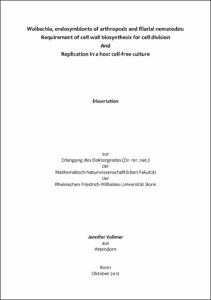Wolbachia, endosymbionts of arthropods and filarial nematodesRequirement of cell wall biosynthesis for cell division And Replication in a host cell-free culture

Wolbachia, endosymbionts of arthropods and filarial nematodes
Requirement of cell wall biosynthesis for cell division And Replication in a host cell-free culture

| dc.contributor.advisor | Hörauf, Achim | |
| dc.contributor.author | Vollmer, Jennifer | |
| dc.date.accessioned | 2020-04-18T17:28:36Z | |
| dc.date.available | 2020-04-18T17:28:36Z | |
| dc.date.issued | 13.03.2013 | |
| dc.identifier.uri | https://hdl.handle.net/20.500.11811/5631 | |
| dc.description.abstract | Obligate intracellular endobacteria of the genus Wolbachia are widespread in arthropods and filarial nematodes. In disease-causing filarial nematode species, responsible for over 150 million cases of human filariasis in tropical regions, these endobacteria are essential for the survival of the worm. Wolbachia depletion by antibiotics is an effective approach for anti-filarial therapy. But the development of drugs suitable for mass drug administration is of urgent need. A specific target for novel antibiotic discovery is the bacterial cell wall since eukaryotes lack an orthologous structure. Thus, the discovery of genes involved in cell wall metabolism in the cell wall-less Wolbachia opened promising possibilities. In this PhD project, insights into the structure of the cell wall precursor lipid II are provided in Wolbachia and a lipoprotein was identified as a potential interaction partner of the molecule. Strikingly, it was found that inhibition of lipid II biosynthesis resulted in impaired cell division in Wolbachia. These results confirmed the biological necessity of lipid II in Wolbachia and indicate a possible secondary function of this molecule in cell wall containing bacteria. In contrast, division defects were not observed subsequent to the depletion of the major cell division protein FtsZ, yielding an uncertain role of FtsZ in cell division of Wolbachia. The investigation of obligate intracellular Wolbachia endobacteria is extremely challenging. In a second part of this PhD thesis the requirements for Wolbachia growth in a host cell-free in vitro culture system were characterized. The supplementation of a cell lysate derived from an insect cell culture facilitated extracellular Wolbachia replication and the bacteria remained viable and infective in this culture for at least 12 days. Furthermore, evidence was given for the growth promoting factors necessary for host cell-free cultivation. In conclusion, intracellular Wolbachia are able to replicate outside their host cell and further steps for the establishment of an extracellular culture system as a powerful tool for molecular biological approaches are discussed. | en |
| dc.language.iso | eng | |
| dc.rights | In Copyright | |
| dc.rights.uri | http://rightsstatements.org/vocab/InC/1.0/ | |
| dc.subject.ddc | 500 Naturwissenschaften | |
| dc.title | Wolbachia, endosymbionts of arthropods and filarial nematodes | |
| dc.title.alternative | Requirement of cell wall biosynthesis for cell division And Replication in a host cell-free culture | |
| dc.type | Dissertation oder Habilitation | |
| dc.publisher.name | Universitäts- und Landesbibliothek Bonn | |
| dc.publisher.location | Bonn | |
| dc.rights.accessRights | openAccess | |
| dc.identifier.urn | https://nbn-resolving.org/urn:nbn:de:hbz:5n-31294 | |
| ulbbn.pubtype | Erstveröffentlichung | |
| ulbbnediss.affiliation.name | Rheinische Friedrich-Wilhelms-Universität Bonn | |
| ulbbnediss.affiliation.location | Bonn | |
| ulbbnediss.thesis.level | Dissertation | |
| ulbbnediss.dissID | 3129 | |
| ulbbnediss.date.accepted | 19.02.2013 | |
| ulbbnediss.fakultaet | Mathematisch-Naturwissenschaftliche Fakultät | |
| dc.contributor.coReferee | Sahl, Hans-Georg |
Files in this item
This item appears in the following Collection(s)
-
E-Dissertationen (4428)




